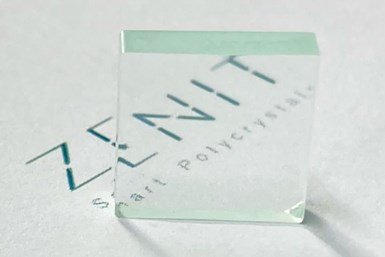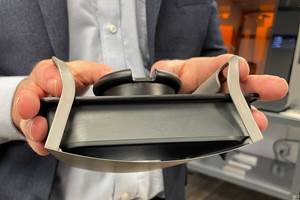Lithoz Supports Zenit Smart Polycrystals’ Materials for Solid-State Lasers
The collaboration includes alignment of Lithoz’s lithography-based Ceramic Manufacturing (LCM) technology for the Zenit process, as well as support for market, organization and innovation strategies.
Lithoz, a provider for ceramic 3D printing, has signed a partnership agreement to support the Italian startup Zenit Smart Polycrystals with entering the solidstate lasers (SSL) market using its process of 3D printing transparent polycrystal components. Zenit is a spin-off from CNR-ISTEC and is based in Faenzak, Italy.
The partnership agreement between Lithoz and Zenit will support the further development and go-to-market of Zenit’s process of 3D printing transparent polycrystal components with variable threedimensional chemical compositions. In addition to the alignment of Lithoz’s lithography-based ceramic manufacturing (LCM) technology for the Zenit production process, the collaboration includes market, organization and innovation strategies.
Lithoz will support the Zenit team on a technical level in aligning its process to the LCM 3D printing technology which the company says is considered the industrial standard for ceramic 3D printing. It will also consider Lithoz's own expertise as both a spin-off and startup in a this innovative, dynamic market environment. Consequently, Lithoz will support its Italian partners along the way to entering the market in terms of answering questions related to innovation strategy, market analysis, licensing and organization.
Lithoz was created as a spinoff 11 years ago from the TU Wien by Dr. Johannes Benedikt and Dr. Johannes Homa. Since then, the company has grown, offering a range of ceramic 3D printers used for various industrial and medical applications.
Zenit, founded last year, will use Lithoz’s LCM process to take its invention to the next level. It is said the printed components feature varying three-dimensional compositions, creating an improved polycrystal material which outperforms the current dominant laser-based technology. By using the ultraprecise LCM technology — which enables equal or superior material properties as those of components produced using conventional forming methods — these smart components can be made even more efficiently to improve performance and open the door to a new generation of new projects.
Lithoz says it actively supports customers in their efforts to bring new applications to the product level through a proactive mutual exchange of experiences and know-how with customers. Working together with clients, the company makes it possible to overcome obstacles and find new methods to achieve its goals by providing maximum support in development by Lithoz experts and engineers.
“Having been working in research and industry for more than 10 years, it is fantastic to see how our industry is growing and being seen as one of the top markets to watch,” says Johannes Homa, Lithoz CEO. “Partnerships are one of our most important values at Lithoz and we invite any innovator looking for support in a challenging project to collaborate with us. We work together with our partners to overcome even the most difficult of technological challenges and to make the future of ceramics happen already today.”
- Watch this episode of The Cool Parts Show to learn about Lithoz’s 3D printed bioceramics that can take the place of both cortical and cancellous bone.
- Learn how Lithoz offers improved ceramic material for 3D printed bone replacements which are patient-specific parts made of hydroxyapatite for bone replacements in the medical and dental field.
- At Formnext 2022, Lithoz showcased its CeraFab S65 ceramic 3D printers which have database-supported storage and management of all process data, enabling seamless documentation of print jobs.
Related Content
Copper, New Metal Printing Processes, Upgrades Based on Software and More from Formnext 2023: AM Radio #46
Formnext 2023 showed that additive manufacturing may be maturing, but it is certainly not stagnant. In this episode, we dive into observations around technology enhancements, new processes and materials, robots, sustainability and more trends from the show.
Read MoreUnderstanding HP's Metal Jet: Beyond Part Geometry, Now It's About Modularity, Automation and Scale
Since introducing its metal binder jetting platform at IMTS in 2018, HP has made significant strides to commercialize the technology as a serial production solution. We got an early preview of the just-announced Metal Jet S100.
Read MoreFormlabs Part Removal Mechanism Enables Lights-Out Production
A build platform overcoming the need for manual part removal enables automated part handling, and therefore continuous production from one build cycle to the next.
Read MoreHow AM Enables Cobot Automation for Thyssenkrupp Bilstein (Includes Video)
The shock absorber maker has responded to its staffing shortages through extensive use of collaborative robots. In-house 3D printing makes this possible by providing the related hardware needed to complete the cobot-automated cells.
Read MoreRead Next
Video: Intelligent Layering Metal 3D Printing at 3DEO
Contract manufacturer 3DEO delivers metal parts using Intelligent Layering, a binder jetting-like 3D printing process the company developed and operates internally. Here’s how it works.
Read MoreLooking to Secure the Supply Chain for Castings? Don't Overlook 3D Printed Sand Cores and Molds
Concerns about casting lead times and costs have many OEMs looking to 3D print parts directly in metal. But don’t overlook the advantages of 3D printed sand cores and molds applied for conventional metal casting, says Humtown leader.
Read More3D Printing Brings Sustainability, Accessibility to Glass Manufacturing
Australian startup Maple Glass Printing has developed a process for extruding glass into artwork, lab implements and architectural elements. Along the way, the company has also found more efficient ways of recycling this material.
Read More








.png;maxWidth=300;quality=90)















